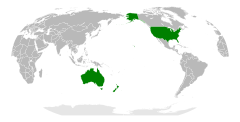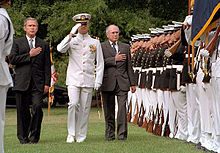Pakt Bezpieczeństwa Pacyfiku
 Logo Paktu Bezpieczeństwa Pacyfiku | |
 państwa członkowskie ANZUS | |
| Język roboczy | |
|---|---|
| Członkowie | |
| Utworzenie | 1 września 1951 |
Pakt Bezpieczeństwa Pacyfiku (ANZUS, ang. Pacific Security Treaty) – sojusz polityczno-wojskowy powołany 1 września 1951 w San Francisco[1], nazywany często ANZUS od pierwszych liter nazw państw-sygnatariuszy Australii (Australia), Nowej Zelandii (New Zealand) i Stanów Zjednoczonych (United States)[2]. Spisany w języku angielskim. Wszedł w życie 29 kwietnia 1952 r. z chwilą złożenia dokumentów ratyfikacyjnych, zarejestrowany przez Sekretariat ONZ 22 maja 1952 r.[3] Depozytariuszem zgodnie z art. 11 jest rząd Australii.
Historia

Powstanie traktatu wiąże się z amerykańską polityką tworzenia antykomunistycznych bloków militarnych i stanowiło odpowiednik NATO w tym rejonie świata. Jego podstawowym celem było stworzenie wzajemnych gwarancji bezpieczeństwa dla krajów członkowskich i zapewnienie bezpieczeństwa w rejonie Oceanu Spokojnego. Gwarantuje on wzajemną pomoc w razie zbrojnego ataku na któregokolwiek z sygnatariuszy. Ten sojusz zawarto po załamaniu się wysiłków Stanów Zjednoczonych Ameryki, mających na celu stworzenie większej organizacji, która miałaby obejmować państwa regionu Azji Południowo-Wschodniej i Oceanu Spokojnego.
ANZUS w wymiarze prawno-traktatowym jest umową sojuszniczą. W wymiarze wojskowym ANZUS jest sojuszem trójstronnym, w którym każde z 3 państw ma zawarte osobne umowy o współpracy wojskowej:
- USA – Australia
- Australia – Nowa Zelandia
- USA – Nowa Zelandia (do 1987)
Po powstaniu w 1954 roku SEATO oba sojusze nawiązały współpracę.
Na mocy postanowień statutu ANZUS wojska australijskie i nowozelandzkie brały udział w wojnie wietnamskiej w latach 1964–1973.
W roku 1987 USA ogłosiły, że traktat przestał obowiązywać w ich stosunkach z Nową Zelandią po tym, jak ogłosiła się ona strefą bezatomową (por. traktat z Rarotonga). Australia wciąż uznaje Nową Zelandię za pełnoprawnego członka.
Zobacz też
- AUKUS
- NATO
Przypisy
- ↑ Australia, New Zealand, United States Security Treaty w Wikiźródłach (ang.).
- ↑ ANZUS, [w:] Encyklopedia PWN [online] [dostęp 2020-10-02].
- ↑ United Nations Treaty Series No. 1736.
Bibliografia
- ANZUS, w: Słownik polityki, pod redakcją Marka Bankowicza, Wiedza Powszechna, Warszawa 1996.
Media użyte na tej stronie
Autor: Archives New Zealand from New Zealand, Licencja: CC BY-SA 2.0
On September 1 1951 the ANZUS military alliance between New Zealand, Australia and the United States was formed. The treaty bound the signatories to recognise that an armed attack in the Pacific area on any of them would endanger the peace and safety of the others. It stated 'The Parties will consult together whenever in the opinion of any of them the territorial integrity, political independence or security of any of the Parties is threatened in the Pacific'. The three nations also pledged to maintain and develop individual and collective capabilities to resist attack.
New Zealand was suspended from ANZUS in 1986 as it initiated a nuclear-free zone in its territorial waters; in late 2012 the United States lifted a ban on visits by New Zealand warships leading to a thawing in tensions. New Zealand maintains a nuclear-free zone as part of its foreign policy . The treaty no longer applies between the United States and New Zealand, but is still in force between either country and Australia, separately.
Shown here is the logo for ANZUS. A copy of the Treaty signed on September 1 is available from the following link, showing a copy of the agreement that Archives New Zealand holds through the Walter Nash collection - archives.govt.nz/gallery/v/Walter+Nash+Exhibition/New+Zea...
Reference for Logo:
ABFK 22686 W4312 12 archway.archives.govt.nz/ViewFullItem.do?code=22243137
For more information email Research.Archives@dia.govt.nz For updates on our On This Day series and news from Archives New Zealand, follow us on Twitter www.twitter.com/ArchivesNZ
Material supplied by Archives New ZealandWith their hands over their hearts, President Bush and Australian Prime Minister John Howard perform a military pass and review at the Washington Navy Yard Sept. 10, 2001. Commemorating 50 years of military alliance, the President and Prime Minister spoke to assembled military personnel, shared lunch and spoke privately in the Oval Office.


